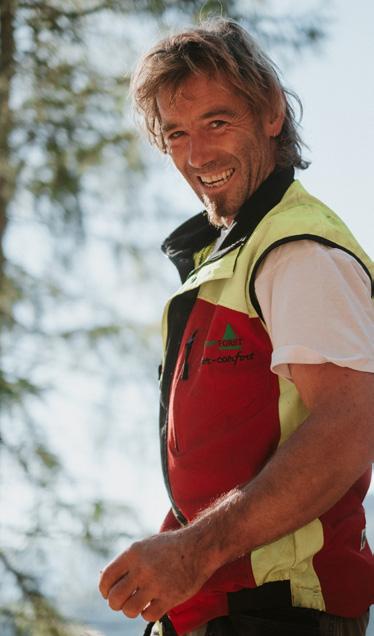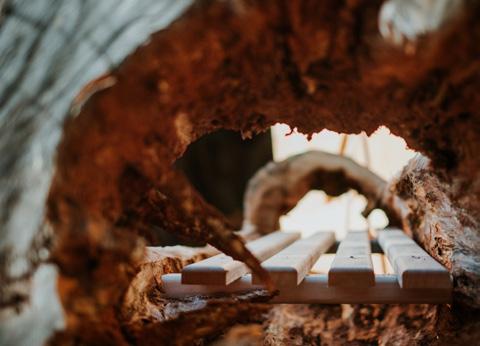
9 minute read
A Day with Wood carver Felix Fischnaller
A Day with… a Wood Carver
In “real life”, Felix Fischnaller is a farmer at Talrasterhof. But his true calling is wood carving. A day in the life of a South Tyrolean with a very particular passion.
Advertisement
Text — MATTHIAS MAYR Photos — MICHAEL PEZZEI

5:00 am
The alarm goes off at the Talrasterhof farm. Felix Fischnaller gets up to go to the stables, feed the ten oxen, check on the four donkeys, the rabbits, the chickens, the ducks. He doesn’t mind getting up so early. When he works away from home, his day starts even earlier, and he will already be in the car by 5 am. After breakfast, he can finally pursue his one great passion: wood carving.
Felix Fischnaller lives with his wife Marlene and their three daughters at the Talrasterhof in Scaleres/Schalders, just above Varna/Vahrn near Bressanone/ Brixen. Together with his family, he takes care of the farm animals, but what he truly loves is being in his workshop.
6:56 am
At seven o’clock at the very latest, Felix Fischnaller will either be in his workshop, on a job away from home, or in the woods looking for a fine piece to work on. Today he has prepared an old tree trunk. This particular “Zirm”, as the Swiss pine is known in South Tyrol, must have been approximately 200 years old when it was felled. Felix Fischnaller has left it in the woods for ten years, exposed to the elements, rotting away, populated by insects. “People used to look at me funny when I left the material lying in nature for years”, says the wood carver. Rather than preserving its flawlessness, the tree trunk has changed and become unique. Nowadays, these deformed, corroded pieces of wood are his signature feature.
He was never interested in beautiful trees with straight trunks; instead, he is enamoured with old, lopsided trunks and branches. “You can tell whether the wood had a tough childhood”, he says with a chuckle. He examines today’s tree trunk with an expert’s eye, trying to find the best use for it. “You can’t bend wood to your will”, he says. “It won’t behave the way you want.”
Felix Fischnaller is a carpenter by trade. He worked as an assembly joiner for thirteen years, and then another sixteen as a forklift operator. In his free time he began to build wooden tables and benches, and over time, more and more orders kept rolling in. He has been self-employed for three years now.
8:38 am
Felix Fischnaller has decided that this trunk is going to become a bench. He surveys the wood, tapping it and listening to the sound it makes. Then he sketches the outline of the bench and roughly cuts the wood into shape using a power saw. With the help of a pickaroon—a tool shaped somewhat like a grappling hook used by lumberjacks and log drivers to move sawn tree trunks—he prises out a large chunk.

The inside of the trunk is exposed: half of it rotted away and eaten through by beetle larvae. The uninitiated might recoil at the sight. Is this really supposed to become a piece of furniture? But he just grins and sets to work.
10:10 am
Using an old adze, a perpendicular axe, Felix Fischnaller carves out the trunk. He removes the rotted interior—including an abandoned wasp’s nest—and soon the aromatic scent of Swiss pine is wafting through the air. He found the adze in an old workshop. He favours this ageing tool: in his opinion, new tools aren’t any good, “except for throwing at someone!” But he cannot go entirely without modern technology. Several power saws are used for the rough cutting of the trunk; a number of machines are kept in the workshop, a band saw, a power plane.
But ultimately, no tool compares to one’s own two hands. He buries them in the wood in order to clear away the chippings, and observing him, one does

Power saws are used for the rough cutting of the trunk. An old adze is Felix Fischnaller’s instrument of choice when it comes to the carving-out.

Scaleres/ Schalders
The mountain village of Scaleres is located at an altitude of 1,035 metres above sea level and has a population of almost 300. A narrow road from the municipality of Varna leads up to the village. The St. Wolfgang’s parish church, consecrated in 1436, is well worth a visit. Scaleres is the starting point of many hiking trails; along the stream to the beautiful Schrüttenseen lakes, for example.


Top. Sliver by sliver the wood carver removes the excess wood until the bench is taking the shape he imagined.
Bottom. Gloves are not an option for Felix Fischnaller. “I need to feel the wood”, says he.
not want to think about the amount of splinters he will jam into his hands. But wearing gloves is not an option. “I need to feel the wood”, says he. He rarely wastes time on using a carpenter’s rule; usually, he works by eye alone. “My eye is more precise than any carpenter’s rule.”
12:05 pm
He has gradually carved out the trunk; the branch attachments jutting into the trunk from the outside in become visible, giving the work piece its unique character. Felix Fischnaller has put the adze aside and now uses a woodcarving knife for the fine work. The Swiss pine wood is soft and supple thanks to the oils it contains, allowing him to drive the knife into the wood with his fist rather than a hammer.
Sliver by sliver he removes the excess wood until the bench is slowly taking the shape he imagined. He does not always get what he originally envisioned. “I just try”, he says, “I can’t keep still, anyway.” He probably inherited his fascination with wood from his father, who died early. “He loved to be out in the woods”, says the son. Together they would pick the right “Zirm” to build sledges. Not children’s sledges, mind you, but the large horn sledges used by local farmers to transport hay from the Alpine pastures down to the valley in winter. These days, Felix Fischnaller makes deck chairs, table and chair sets, fences, toys, swing sets, and garden sheds, along with the occasional night stand fashioned from a tree trunk, home décor items, or an oversized wooden wheel of cheese for a dairy business. Some of the material comes from his own woods, but sometimes he also buys larger quantities of uncut firewood, which usually include some good pieces. Wood is stacked up all around the workshop; some of the stacks have been here for years. Fischnaller’s raw material also includes planks from a 1749 hay barn, more than a quarter of a millennium old, but still in excellent condition. The wood has a personality, which he aims to preserve.
1:55 pm
It’s past lunchtime already, but the woodcarver wants to keep working. The wood has him spellbound. Often his wife will come out and bring him a “Marende”, the traditional Tyrolean afternoon snack, which he will then enjoy in front of the workshop at a small table with a splendid view of both the valley with the village church and the peaks of the Gruppo delle Odle/Geisler in the distance. But today, he skips his Marende with a view. “Marlene sometimes chides me for that”, he admits.
Felix Fischnaller still needs a few more hours of work until the bench is finished. From time to time he walks around in the woods, looking for trunks and branches for his work.

But she probably also knows that she won’t be able to change him.
Life as a farmer and a wood carver can sometimes be a bit much. But Felix Fischnaller won’t hear anything about giving up the Talrasterhof. “I’m fond of this farm”, he says. He took it over in 1998 and has put a lot of effort into its renovation since then. “The farm dates back to the 1500s. It is my duty to keep it alive.” Not least because he trusts that one of his daughters will one day be the Talraster farmer. The combination of the farm and the woodcarving guarantees their income.
4:20 pm
Vera, the youngest of his three daughters, pops into the workshop after school. The eleven-year-old picks up a piece of wood and a woodcarving knife, sits down in a corner, and starts crafting, forgetting everything around her. “I almost forget she’s here”, says her father. Quite obviously, he has passed on his passion for wood to Vera, but his other daughters—aged 18 and 20—are very practically-minded, too.
6:30 pm
Felix Fischnaller still needs a few more hours of work until the bench is finished and looks the way he wants it to. From time to time he walks around in the woods, looking for trunks and branches for his work. He is not needed at the farm during the day. He has given up dairy farming, even though he won the Young Mountain Farmers Award in 2004 as well as an award for the best milk in South Tyrol. The oxen he keeps for meat production spend the summer on the Alpine

There are approx. 300 million trees in South Tyrol, 99% of which are conifers.
pastures and do not require a lot of work in winter, and neither do the trout he breeds in a small pond.
9:05 pm
Fischnaller’s day usually ends at around nine or ten o’clock in the evening. His wife has mucked out the stables in the meantime, fed the cattle, and prepared supper. They spend the last of the evening together. He used to finish even later, at almost midnight. “But then I wouldn’t get any supper”, he says with a grin.
So he has slowed down somewhat. Just like a tree needs time to grow and mature in the woods, a man needs time to rest and recuperate. He wouldn’t have agreed when he was younger. Now he does. “I’m getting older, I can feel it”, he says. But for the time being, Felix Fischnaller can be found every day in his workshop at the Talrasterhof in Scaleres. Because, you know, he couldn’t keep still, anyway.










